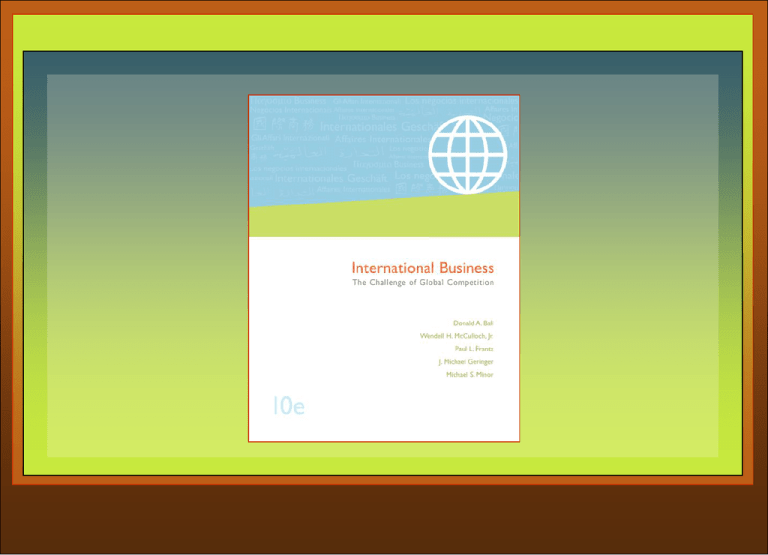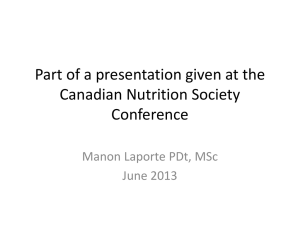
This chapter covers:
14
•Environmental
analysis and market
screening
•Market indicators and
factors
Assessing and Analyzing
Markets
•Market demand
•Trade missions
•Problems with
marketing research
•Country and segment
screening
•The internet as a
market research tool
International Business
by Ball, McCulloch, Frantz,
Geringer, and Minor
McGraw-Hill/Irwin
Copyright © 2006 The McGraw-Hill Companies, Inc. All rights reserved.
Chapter Objectives
Discuss environmental analysis and market screening
Explain market indicators and market factors
Describe some statistical techniques for estimating market
demand and grouping similar markets
Appreciate the value to businesspeople of trade missions and
trade fairs
Discuss some of the problems market researchers encounter in
foreign markets
Understand the differences between country screening and
segment screening
Identify sources of information for the screening process
Appreciate the utility of the Internet as a source of market
research data
14-3
Assessing and Analyzing Markets
Market Screening
A modified version of
environmental scanning in
which the firm identifies
markets by using the
environmental forces to
eliminate the less desirable
markets
Environmental Scanning
14-4
A procedure in which a firm
scans the world for changes
in the environmental forces
that affect it
Market Screening
Permits management to identify a small number of
desirable markets be eliminating those less
attractive
Two Types of Screening
Country Screening
Using countries as the basis for market selection
Segment Screening
Using market segments as the basis for market
selection
14-5
Initial Screening
Basic Need Potential
14-6
If the need is lacking,
then no reasonable
expenditure of effort and
money will enable the
firm to market its goods
and services
Easier for producers of
specialized industrial
materials or equipment
than for widely
consumed products
Foreign Trade and
Investment
If the need potential
cannot be readily
established for the good
or service, analysts can
use
U.N.’s International
Trade Statistics
Yearbook, Volume II to
identify export and
import quantities
Foreign Trade and Investment
Other helpful resources include
International Trade Administration site on the
Internet (www.ita.doc.gov)
U.S. Exports of Merchandise on the National
Trade Data Bank
U.S. International Trade in Goods and Services
(FT900) by the Department of Commerce
Annual Worldwide Industry Reviews and
International Market Research Reports prepared
by various U.S. embassies
14-7
Second Screening
Financial and Economic Forces
Financial Forces
Trends in inflation
Exchange rates
Interest rates
Credit availability
Paying habits of
customers
Rates of return on
similar investments
14-8
Economic Forces
Measures
of market demand based on
economic data include
Market indicators
Market factors
Trend analysis
Cluster analysis
14-9
Economic Forces
Market Indicators
Economic data used to
measure relative market
strengths of countries or
geographic areas
Buying Power Index
enables marketers to
compare relative
buying power
14-10
Market Factors
Economic data that
correlate highly with
market demand for a
product
If the analyst of a
foreign market has no
factor for that market,
he or she can use the
“estimation by
analogy”
Economic Forces
Trend Analysis
A statistical technique by
which successive
observations of a variable
at regular time intervals
are analyzed to establish
future values
Cluster Analysis
14-11
A statistical technique that
divides objects into groups
so that the objects within
each group are similar
Third Screening
Political and Legal Forces
Entry Barriers
Profit Remittance Barriers
Import restrictions, local participation requirements,
local content restrictions, government-owned
competition
Undue restrictions on repatriation of earnings, limits
to FDI, inability to provide foreign exchange
Policy Stability
14-12
Political climate, government stability, public unrest
Fourth Screening
Sociocultural Forces
Screening on the basis Sources of assistance to
of sociocultural factors
is challenging
Sociocultural factors
are fairly subjective
“Data” are difficult
to assemble,
particularly from a
distance
14-13
analyze and interpret
sociocultural forces
include
Consultants
U.S. Department of
Commerce specialists
Professional
organizations and
universities
Fifth Screening - Competitive Forces
The number, size, and
financial strength of the
competitors
Their market shares
Their marketing strategies
The apparent effectiveness
of their promotional
programs
The quality levels of their
product lines
14-16
The source of their products-imported or locally
produced
Their pricing policies
The levels of their after-sales
service
Their distribution channels
Their coverage of the market
Competitive Forces
Countries where strong
competitors make a
profitable operation difficult
are eliminated from list
unless management
is following a strategy of
being present wherever
its global competitors are
believes entering a
competitor’s home
market will distract the
competitor’s attention
from its home market
14-15
Final Selection of New Markets
A personal visit to potential markets is essential is selecting
markets. Visits to potential markets can be through
A Field Trip
Should not be hurried
Government-Sponsored Trade Mission
A group of business or government people visit markets
in search of business opportunities
Less cost than going alone and greater impact
Trade Fairs
A large exhibition at which companies maintain booths
to promote the same of their products
14-16
Final Selection of New Markets
Research in Local market
Face-to-face interviews
reveal information that
would never be written
Management should hire
a local research group
14-17
The person in charge of
the project must have
experience in that
country on one culturally
similar in the same
geographic area
Local Research Problems
Cultural
Language
Literacy
Social desirability bias
Technical
14-18
No up-to-date maps
Streets have different names
Houses not numbered
Only wealthy have
telephones
Mail deliveries can take
weeks or cost money
Final Selection of New Markets
Research as Practiced
Competition is frequently less intense in
developing nations because
there are fewer competitors
management is struggling with problems other
than marketing, which keep them from
devoting more time to the marketing function
14-19
Segment Screening
Segment Screening
14-20
Definable
Identify and measure
Large
Large enough to be worth the effort needed
Accessible
Reachable for either promotional or distribution
purposes
Actionable
Able to control the components of marketing programs
Capturable
The potential still exists to “capture” the segment
TRADE MISSION CALENDAR
February 15-16, 2005 Explore BC - Vancouver, Canada
March 16-17, 2005 Men's Cosmetics and Skin Care
Trade Mission - Montreal, Canada
March 15-20, 2005 Aerospace Executive Service at the
Australian International Airshow - Avalon Airport,
(Geelong) Australia
June 7-8, 2005 Explore BC - Vancouver, Canada
June 14-15, 2005 REPCAN 2005 - Toronto, Canada
UK Trade Fairs
trade fairs and exhibitions UK offers
a comprehensive listing of all the
consumer, public, industrial and trade
exhibitions to be held in major venues
around the UK







